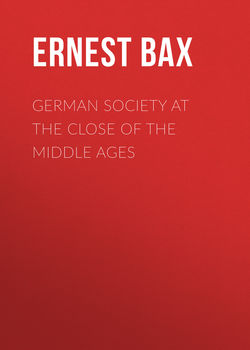German Society at the Close of the Middle Ages

Реклама. ООО «ЛитРес», ИНН: 7719571260.
Оглавление
Bax Ernest Belfort. German Society at the Close of the Middle Ages
CHAPTER I. FIRST SIGNS OF SOCIAL AND RELIGIOUS REVOLT
CHAPTER II. THE REFORMATION MOVEMENT
CHAPTER III. POPULAR LITERATURE OF THE REFORMATION
CHAPTER IV. THE FOLKLORE OF THE REFORMATION
CHAPTER V. THE GERMAN TOWN
CHAPTER VI. THE REVOLT OF THE KNIGHTHOOD
CHAPTER VII. COUNTRY AND TOWN AT THE END OF THE MIDDLE AGES
CHAPTER VIII. THE NEW JURISPRUDENCE
APPENDICES
APPENDIX A
APPENDIX B
APPENDIX C
Отрывок из книги
The close of the fifteenth century had left the whole structure of mediæval Europe to all appearance intact. Statesmen and writers like Philip de Commines had apparently as little suspicion that the state of things they saw around them, in which they had grown up and of which they were representatives, was ever destined to pass away, as Lord Palmerston or any other statesman of the Cobden-Bright period had that the existing system of society, say in 1860, was at any time likely to suffer other changes than those of detail. Society was organised on the feudal hierarchy of status. In the first place, a noble class, spiritual and temporal, was opposed to a peasantry either wholly servile or but nominally free. In addition to this opposition of noble and peasant there was that of the township, which, in its corporate capacity, stood in the relation of lord to the surrounding peasantry.
The township in Germany was of two kinds – first of all, there was the township that was "free of the Empire," that is, that held nominally from the Emperor himself (Reichstadt), and secondly, there was the township that was under the domination of an intermediate lord. The economic basis of the whole was still land; the status of a man or of a corporation was determined by the mode in which they held their land. "No land without a lord" was the principle of mediæval polity; just as "money has no master" is the basis of the bourgeois world with its self-made men. Every distinction of rank in the feudal system was still denoted for the most part by a special costume. It was a world of knights in armour, of ecclesiastics in vestments and stoles, of lawyers in robes, of princes in silk and velvet and cloth of gold, and of peasants in laced shoe, brown cloak, and cloth hat.
.....
The knighthood or smaller nobles, no longer content with homely fare, sought after costly clothing, expensive food and exotic wines, and to approach the affluent furnishing of the city magnate. His one or two horses, his armour, his sword and his lance, his homespuns made almost invariably on his estates, the wine grown in the neighbourhood, his rough oatmeal bread, the constituents of which had been ground at his own mill, the venison and wild fowl hunted by himself or by his few retainers, no longer sufficed for the knight's wants. In order to compass his new requirements he had to set to work in two ways. Formerly he had little or no need of money. He received, as he gave, everything in kind. Now that he had to deal with the beginnings of a world-market, money was a prime necessity. The first and most obvious way of getting it was to squeeze the peasant on his estate, who, bitten by the new mania, had also begun to accumulate and turn into cash the surplus products of labour on his holding. From what we have before said of the ways and manners of the knighthood, the reader may well imagine that he did not hesitate to "tower" the recalcitrant peasant, as it was called, that is, to throw him into his castle-dungeon if other means failed to make him disgorge his treasure as soon as it came to his lord's ears that he had any. But the more ordinary method of squeezing the peasant was by doubling and trebling the tithes and other dues, by imposing fresh burdens (many of them utterly unwarranted by custom) on any or no pretext. The princes, lay and ecclesiastic, applied the same methods on a more extended scale. These were often effected in an ingenious manner by the ecclesiastical lords through the forging of manorial rolls.
The second of the methods spoken of for "raising the wind" was the mortgaging of castle and lands to the money-lending syndicates of the towns, or, in the case of the greater princes, to the towns themselves in their corporate capacity. The Jews also came in for their share of land-mortgages. There were, in fact, few free or semi-free peasants whose lands were not more or less hypothecated. Meanwhile prices rose to an incredible extent in a few years.
.....